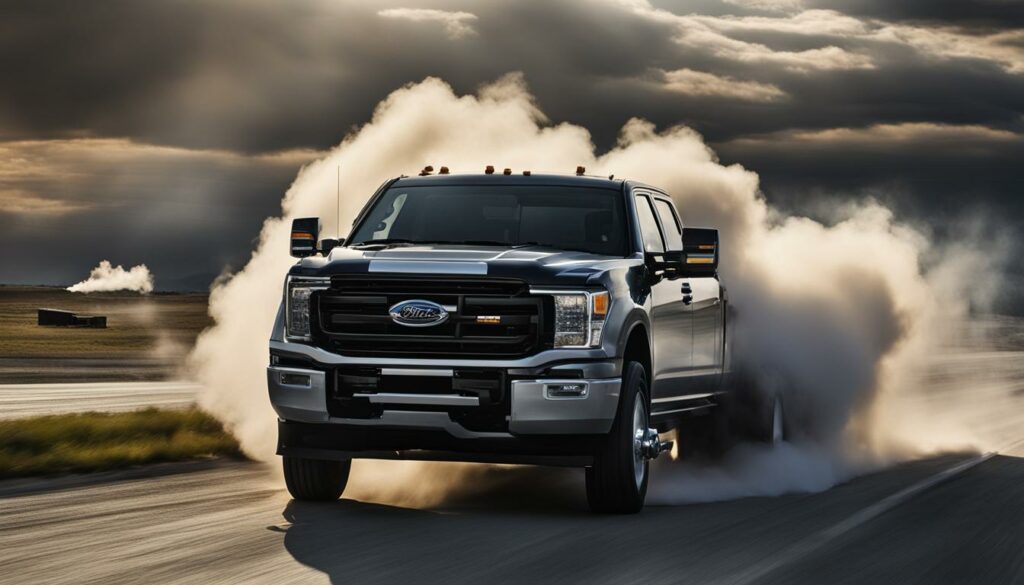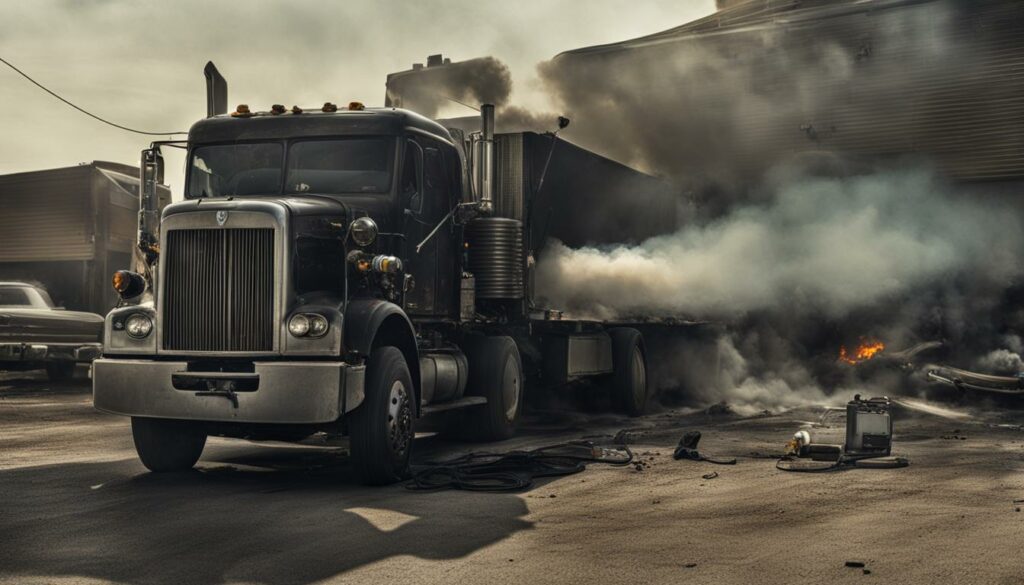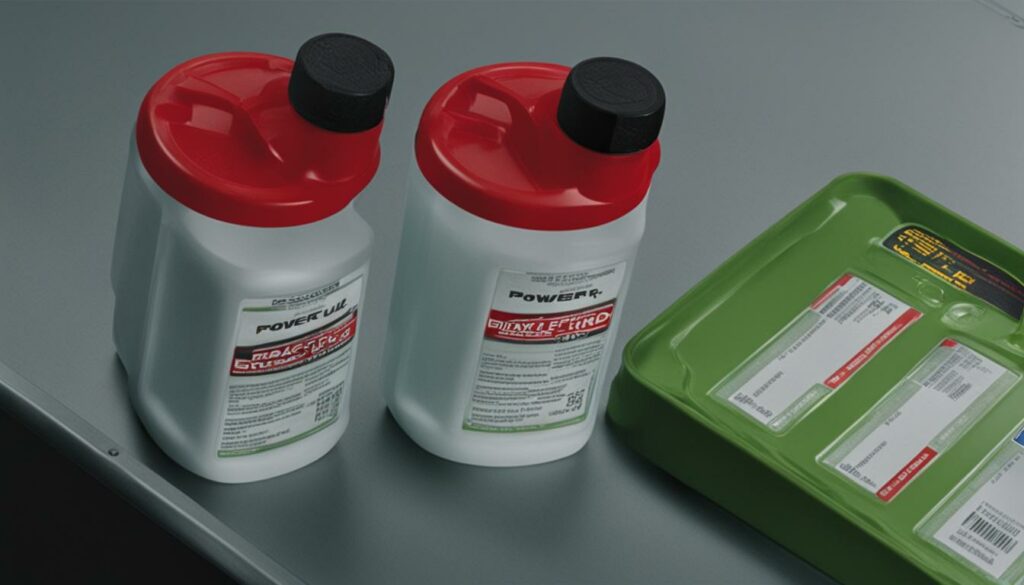If you’re experiencing truck backfiring, it can be a frustrating and concerning issue. Backfiring occurs when the engine’s combustion process is disrupted, causing a loud ‘pop’ or ‘bang’ sound from the exhaust. It can also result in a decrease in fuel efficiency and engine performance. However, before you start worrying about major engine repairs, there are several common causes of truck backfiring that you can easily address.
The backfiring issue might be due to problems with the engine, air-fuel mixture, spark plugs, ignition timing, or exhaust. In this section, we’ll guide you through the common reasons why your truck might be backfiring and suggest appropriate fixes to address this problem more effectively.
Key Takeaways:
- Backfiring occurs when the engine’s combustion process is disrupted, leading to a loud ‘pop’ or ‘bang’ sound from the exhaust.
- The most common causes of truck backfiring are issues with the engine, air-fuel mixture, spark plugs, ignition timing, or exhaust.
- Understanding the underlying causes of backfiring can help diagnose and resolve the problem more effectively.
- Checking the air-fuel mixture, inspecting spark plugs and ignition timing, examining the exhaust system, and understanding misfires and fuel system problems are the key ways to address backfiring issues.
- Professional help should be sought if you’re unsure or need further assistance.

Checking the Air-Fuel Mixture
One of the potential reasons your truck is backfiring is due to an imbalanced air-fuel mixture. The air-fuel mixture plays a vital role in the combustion process which powers your engine. If the ratio of air to fuel is not correct, it can negatively affect the combustion process and cause backfiring.
To check the air-fuel mixture, you will need to inspect your fuel system. This includes, but is not limited to, the fuel pump, fuel injectors, and carburetor. If you have a fuel-injected engine, you may need to use a diagnostic tool to assess the air-fuel mixture. On the other hand, if you have a carburetor engine, you may be able to adjust the mixture manually using the screws located on the carburetor.
| Problem | Solution |
|---|---|
| Lean Air-Fuel Mixture | Adjust the carburetor screws or diagnose and repair faulty fuel injectors or fuel pump. |
| Rich Air-Fuel Mixture | Adjust the carburetor screws or diagnose and repair a malfunctioning oxygen sensor. |
It’s essential to have a balanced air-fuel mixture to ensure proper combustion and prevent backfiring. A correctly balanced mixture will also improve engine performance and fuel efficiency.
Your air-fuel mixture affects the combustion process and engine performance, so it’s crucial to keep it in good condition. Regular maintenance and inspection are critical to avoid potential backfiring problems.
Inspecting the Spark Plugs and Ignition Timing
Checking your spark plugs and ignition timing is crucial to ensure smooth engine performance and prevent backfiring. Faulty spark plugs or timing can lead to incomplete combustion, resulting in unburned fuel igniting in the exhaust system and causing loud, popping noises.
Begin by visually inspecting your spark plugs for signs of wear or damage. If a spark plug is fouled or worn, it may not be firing effectively, leading to misfires and backfiring. Use a spark plug wrench to remove each plug, inspecting them one at a time. If you notice any signs of damage, replace them immediately.
Next, check your ignition timing. Ignition timing refers to the sequence in which the spark plugs fire in the cylinders. If the timing is too advanced or too retarded, it can cause backfiring and other issues. Use a timing light to observe the timing marks while the engine is running. Refer to your vehicle’s manufacturer specifications to adjust the timing as needed.
If you’re unsure how to inspect your spark plugs or adjust your ignition timing, consult your vehicle’s manual or a professional mechanic. They can help you diagnose and resolve any issues in a safe and efficient manner.
Examining the Exhaust System
The exhaust system plays a crucial role in your truck’s performance, but it’s often overlooked when troubleshooting the backfiring issue. Backfiring can occur due to a malfunctioning exhaust system, such as leaks, clogs, or other issues that interfere with the engine’s combustion process. Let’s examine how to diagnose and fix these exhaust-related problems to eliminate backfiring and restore your truck’s smooth operation.
Checking for Leaks
One of the most common exhaust problems is leaks, which can disrupt the air-fuel ratio and lead to backfiring. You can check for leaks by running your truck and inspecting the exhaust system for any hissing or popping sounds, or by using a smoke machine to detect any visible leaks. Once you locate the leak, you can use a sealant or replace the damaged component, such as a gasket, to fix the problem.
Examining for Clogs
Clogs can also cause backfiring by preventing the proper flow of exhaust gases. A clog in the exhaust system can result in the engine having to work harder, leading to an unbalanced air-fuel mixture and backfiring. You can check for clogs by visually inspecting the system or using a diagnostic tool to measure the exhaust pressure. To fix the clog, you may need to remove the affected component and manually clean or replace it.
Upgrading Exhaust System
If your truck’s exhaust system is old or damaged beyond repair, it may be time to upgrade to a newer system that’s more efficient and provides better performance. Upgraded exhaust systems are designed to improve airflow and reduce backpressure, helping to optimize combustion and prevent backfiring. You can choose from a variety of exhaust system types, such as cat-back, axle-back, or header-back, depending on your specific needs and budget.
By examining your truck’s exhaust system and addressing any leaks or clogs, or upgrading to a newer system, you can effectively eliminate backfiring and improve your truck’s engine performance. Don’t hesitate to seek professional assistance if you’re unsure about how to perform any of these checks or fixes.

Understanding Misfires and Fuel System Problems
If you’ve ruled out an imbalanced air-fuel mixture, faulty spark plugs, and issues with your exhaust system, it’s time to consider misfires and fuel system problems as possible causes of your truck’s backfiring.
A misfire occurs when the fuel in your engine’s cylinders fails to ignite properly. This can result in a loss of power, rough idling, and yes, backfiring. Common causes of misfires include:
- Worn or damaged spark plugs
- Faulty ignition coils
- Clogged fuel injectors
- Low fuel pressure
If you suspect that a misfire is causing your truck to backfire, it’s important to diagnose and resolve the issue promptly. You can use a diagnostic scanner or code reader to identify which cylinders are misfiring and then take appropriate action to address the problem.
Another possibility is that there may be a problem within your fuel system, which can cause your truck to backfire. Here are some common fuel system issues:
- Fuel filter clogs
- Fuel pump failures
- Malfunctioning oxygen sensors
If you suspect that your fuel system is the culprit, it’s important to take your truck to a professional mechanic who can pinpoint the issue and determine the best course of action.
Remember, ignoring misfires or fuel system problems can lead to more serious issues down the road, so it’s important to address them promptly.

Conclusion
Congratulations, you’ve made it to the end of our guide! We hope you found this article helpful in understanding why your truck might be backfiring and how to fix the problem. Remember that preventing backfiring starts with proper maintenance and regular check-ups.
Always keep an eye on your air-fuel mixture, spark plugs, ignition timing, and exhaust system. If you notice any issues, make sure to address them promptly to avoid further damage to your engine.
If you’ve tried all the fixes outlined in this article and are still experiencing backfiring, it might be time to consult a professional mechanic. They can help diagnose the problem and provide a more specific solution based on your truck’s make and model.
By taking care of your truck’s engine and addressing any issues as soon as they arise, you’ll ensure a smoother and safer ride. We hope you found this guide helpful and wish you the best of luck in your truck repair endeavors!


